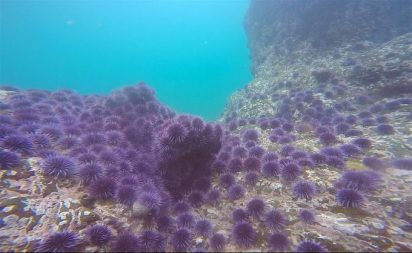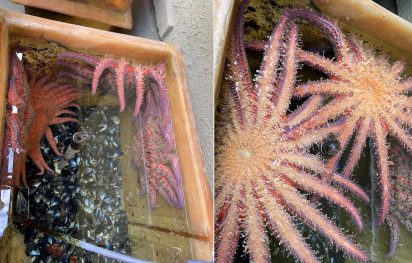Hope after a gruesome marine disease: spotting the critically endangered sunflower sea star in Washington
If you’ve ever visited a rocky tide flat at low tide, you’ve inevitably experienced the tumultuous traverse through boot-sucking mud that accompanies such excursions. I’ve found that, for me, the slog through the mud is always worth the effort to see diverse species in their natural habitats. I’ve never shied away from getting my hands dirty in the field, and this attitude has led me to some irreplaceable animal encounters, including one this summer where I got to see one of my favorite sea stars out in the wild – the critically endangered sunflower sea star (Pycnopodia helianthoides).
This summer I had the extraordinary opportunity of being a Teaching Assistant (TA) at Friday Harbor Labs (FHL) on San Juan Island in the Puget Sound. Each day was an opportunity to explore the island and learn through immersive, field-based experiences. Our conservation ecology class spent hours identifying invertebrates in the tidepools, scanning the horizon for whales, looking through binoculars at birds, and digging through mud for worms and clams. Every day out in the sun and the sea breeze was an amazing day.
During one day with a particularly low tide, we set out on an adventure to find brittle stars in the cracks of rocks but quickly changed our focus when a student flipped one over to uncover a bright red alien-like creature. In front of us was a pizza-sized sea star clinging to the rocks, something I didn’t think I would ever have the chance to see in the wild.

Once abundant along the west coast from Unalaska Island, Alaska, to Baja California, the sunflower sea star has fascinated researchers and the public with its size, speed, and stunning coloration. This sea star is one of the largest and fastest in the world, with sizes reaching up to one meter in diameter. Sunflower sea stars have an array of 16-24 individual arms, which is many more than the five armed species that people usually think about when they think of sea stars. Pycnopodia come in many vibrant colors, ranging from browns and oranges to bright purple and reds. Using their 15 thousand individual tube feet, they can move up to one meter per minute, which helps them be voracious predators.
Unfortunately, the sunflower sea star was one of the species hit the hardest by the 2013 outbreak of sea star wasting syndrome (SSWS), which decreased the population size by 90% in the Salish Sea and landed the star on the Red List of Threatened Species of the International Union for Conservation of Nature, an international policy tool that assesses the extinction risk for various species but is not legally binding in the United States.

Sea Star Wasting Syndrome
Sea star wasting syndrome is a devastating disease that affects at least 20 different species of sea stars. Characterized by white lesions, twisted or missing arms, deflation, and eventual disintegration, SSWS causes a gruesome and gooey death for sea stars. Although mass sea star die-offs are not new, SSWS caused the largest wildlife mass die-off event ever recorded. Since 2013, SSWS has caused population declines in sea stars all along the coast, ranging from Mexico to Alaska. The sunflower sea star was hit particularly hard, suffering a loss of nearly six billion individuals and becoming functionally extinct south of Monterey Bay, California. Although listed as critically endangered on the IUCN Red List, this species is still only a candidate for protection under the United States Endangered Species Act – a legally binding conservation policy in the United States.
Unfortunately, much is still unknown about what causes this disease or how to stop it. Researchers once thought a virus caused SSWS, but laboratory studies have been conducted to disprove this. The cause of SSWS is still unknown, but researchers believe warming ocean temperatures exacerbate the problem. When sea surface temperatures are higher, SSWS is more likely to be transmissible and lead to mortality. This is common for many marine diseases, warming temperatures can cause disease to spread more rapidly. With climate change causing sea surface temperatures to steadily rise, marine infectious diseases could continue to have a huge impact on many species.
Ecological Implications
The loss of the sunflower sea star can also have significant ecological impacts. The sunflower sea star is a top predator in kelp forests and helps control the urchin population by feeding on them. Sunflower sea stars are considered keystone species, and losing them can have cascading effects that destabilize the entire ecosystem, resulting in a trophic cascade. The loss of essential predators in the ecosystem—like the sunflower sea star—decreases predation on urchins and can lead to a significant decline in kelp. Because kelp is a primary food source for urchins, when urchin populations boom, they overgraze entire kelp forests, altering the ecosystem and leading to massive urchin barrens.

The loss of predation on urchins by the sunflower sea star is comparable to the same loss of predation by sea otters. Sea otters are also voracious predators of urchins and help control their populations. Unfortunately, in the 18th and 19th centuries, sea otters were nearly hunted to extinction. However, sunflower sea stars were able to eat enough urchins in kelp forests without sea otters to keep the ecosystem in balance. Without these two important predators, kelp forests are vulnerable to overgrazing by urchins and may face significant losses.
Kelp forests are important ecosystems that support high biodiversity and climate resilience. They are essential habitats for several species of fish, invertebrates, and marine mammals and provide food and shelter to these animals. Kelp forests also aid in the fight against climate change by sequestering carbon from the atmosphere and reducing storm surges. Their large fronds create drag in the water and slow down ocean currents, which mitigates damage from climate change related storms and prevents coastline erosion. Indeed, healthy kelp forests provide a slew of ecosystem benefits to animals and people. However, kelp forests are under threat and an estimated 95% of them have been lost in California. Increased predation on kelp by urchins in the absence of predators like sea otters and the sunflower sea star can cause entire forests to disappear.
Sunflower Sea Star Recovery Efforts
Fortunately, this story is not entirely a sad one. Many researchers and citizen scientists are working tirelessly to learn more about SSWS and work to recover affected species and kelp forests. One of the researchers leading this effort is based out of the University of Washington’s Friday Harbor Labs. Jason Hodin’s captive breeding program at FHL shows promising indicators that sunflower sea stars may be able to recover, and his lab is working actively to support these efforts.
Hodin’s work centers around working to establish a captive breeding program for these stars. This process involves rearing juvenile sea stars in the lab with the hope they will become adults that can be reintroduced into the wild. Studying these creatures in a lab from their juvenile stage to their adult stage has provided Hodin and his team with important information about sunflower sea stars throughout their entire life cycle, and this information will aid in population recovery efforts.
For instance, Hodin and his team have observed juvenile sunflower sea stars eating a hearty diet of juvenile urchins, which is ecologically important because it indicates that sunflower sea stars are exhibiting top-down predation on urchins throughout their entire life cycle, not just as adults. According to Hodin, “when the juvenile size of the sunflower stars gets up to about five or six millimeters, they can eat as many as five, six, or seven juvenile urchins per day, unlike the adults which are maybe eating about one urchin a day.” Such observations open avenues for future research on food web interactions in kelp forests and can help scientists better understand urchin population control and predation from sunflower sea stars.

These lab-based efforts have aided in recovery and resulted in new and novel observations about sunflower stars. Hodin and his team are also researching how warming temperatures impact sunflower sea star spawning and rearing and hope to better understand how SSWS impacts these animals. They hope that the more they learn about the biology and life cycle of sunflower sea stars, the better the chances are at determining the best steps for recovery. Although more research is needed, these preliminary observations offer insight into important ecological interactions and might hold the key to better understanding kelp forest recovery and sea star wasting syndrome.
I was lucky to have the opportunity to view these magnificent creatures in the wild this summer and was amazed at their unique body shape, size, and coloration. Our class saw a total of eight adult sunflower sea stars throughout our summer. Seeing so many of these creatures in the wild and bearing witness to recovery efforts at FHL has given me hope that the species will be able to recover in the wild and be around for years to come. The next time you are traversing the intertidal, keep your eyes peeled and maybe you will be fortunate enough to observe one of these colorful, alien-like animals in the wild as well.